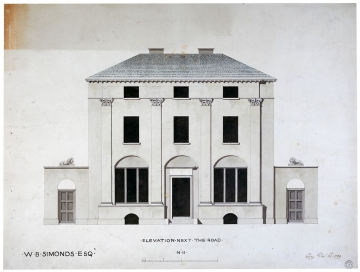
Browse
Reference number
Purpose
Aspect
Scale
Inscribed
5 as above and W.B.Simonds Esqr
Signed and dated
- 4 Copy December 30th 1789
5 Copy Decr 30th 1789
Medium and dimensions
Hand
Watermark
Notes
Soane borrowed from his initial design for the front elevation of Saxlingham Rectory, Norfolk, 1784 (q.v.) for the composition and window details of design II (and see also note to drawing 3).
The accompanying plans have not survived but there are survey plans and an elevation made 13 years later (drawings 6-10). See drawing 3 for a perspective close to drawing 2 except that a) the service entrances have gone (b) the eaves cornice has migrated to below the attic windows and (c) the order is now a conventional Ionic. A circa 1900 photograph (SM Information Files) of the three-bay house heavily clad with wisteria and ivy shows it in use as an office. Built of brick with Ionic pilasters and a cornice with T-shaped toothing below the attic. There is also a wreath above the door that is probably the tablet with carving of hops and hop leaves ordered from Foxhall in 1791.
Soane's office 'Ledger B' has an entry for 27 February 1792 that records payments for slates, white bricks, stone, Sealy for artificial stone and composition ornaments, as well as Foxhall and Hall for paper-hanging suggesting that the house was built and finished by that date. Two patterns of paper bordered with hops were sent by post in 1791
Level
Sir John Soane's collection includes some 30,000 architectural, design and topographical drawings which is a very important resource for scholars worldwide. His was the first architect’s collection to attempt to preserve the best in design for the architectural profession in the future, and it did so by assembling as exemplars surviving drawings by great Renaissance masters and by the leading architects in Britain in the 17th and 18th centuries and his near contemporaries such as Sir William Chambers, Robert Adam and George Dance the Younger. These drawings sit side by side with 9,000 drawings in Soane’s own hand or those of the pupils in his office, covering his early work as a student, his time in Italy and the drawings produced in the course of his architectural practice from 1780 until the 1830s.
Browse (via the vertical menu to the left) and search results for Drawings include a mixture of Concise catalogue records – drawn from an outline list of the collection – and fuller records where drawings have been catalogued in more detail (an ongoing process).




